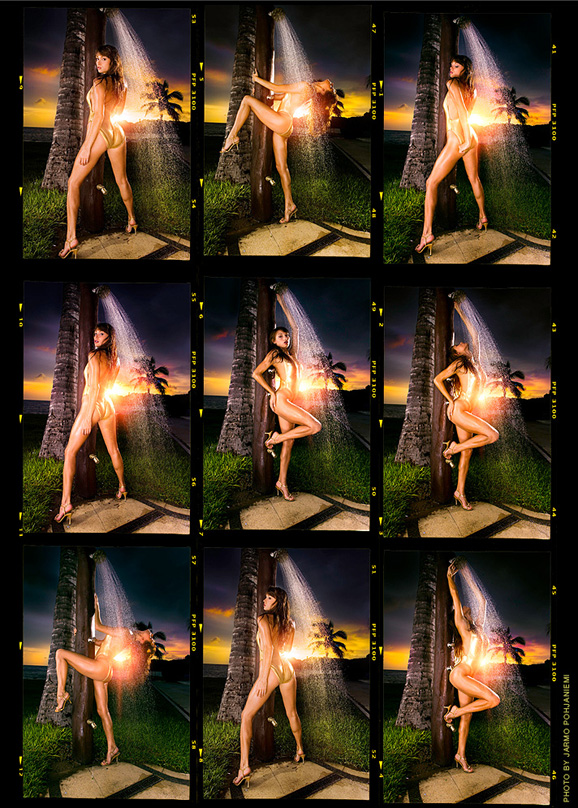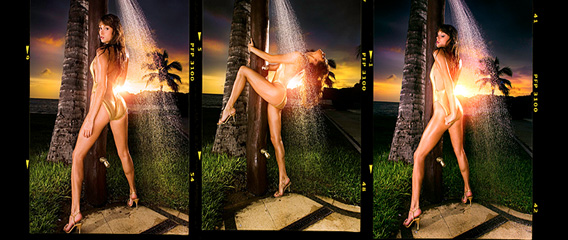Don’t Let the Sun Go Down on You
Some time ago, I was on my way to Mexico’s west coast for a photoshoot. Our editor had hopes that I would return with wonderful exotic images that could be printed in the glossy pages of Playboy.
Before I boarded my flight, he called me to say that I should also make sure to bring great sunset images for the summer issue, and that he was running short of these kind of pictorials.
At first, my destination location to shoot the images was set for Puerto Vallarta. However, I found everything I saw there quite boring and not very stimulating at all. I heard that there was a hurricane headed to the resort area of Costa Careyes, which was about a five-hour drive down south and the entire area had been evacuated for safety reasons. I saw an opportunity, knowing that some of the most spectacular sunsets occur right before the arrival of a storm due to the unusual cloud activity.
I told our team to pack our stuff and head down south. They replied and politely told me in no uncertain terms that I had basically lost my freakin’ mind and I was absolutely crazy to attempt such a thing. That being said, we were soon in our vehicles and head southward and into the jaws of the hurricane.
During our drive to the location, we soon realized we were the only ones heading toward the storm as hundreds of vehicles were driving away from the evacuated area. I clearly knew I was taking a risk, but I also knew that if my plan worked I would get some stunning cloud and sunset combination shots and possibly a low-cost location due to no one being in the exclusive resort area.
I picked one of the most luxurious villa resorts CASTLE SOL DE OCCIDENTE that usually charges $5,000 to $10,000 a day, but was now completely empty due to the hurricane warnings. After negotiating a deal with the hotel resort manager and the minimal staff who had stayed behind to take care of the resort, I was able to talk him into a $1,000 location and a hotel fee for the entire three days. (What a deal!) In the end, we had the whole beautiful place to ourselves, just me and my crew of 12 people.
But that’s not the end of it! The best thing about it all was that the hurricane never reached us. Instead, it turned north and side swept us, leaving us high and dry with nothing to remember it by except for the most spectacular sunset and storm cloud creations ever!
So by now you probably asking, “Jarmo, aren’t there plenty photographers who have shot sunset images during the golden hour?” This seems to be every photographer’s excuse to take a gorgeous model to the beach and shoot during the beautiful, smooth, yellow-reddish light.
This was exactly what our editor did not want. He explains that he wants to have the actual sun and the model in the frame at the same time instead of having the sun’s POV (point of view) directly on the model.
 The reason why this so-called “golden hour” light is very critical for editors is that it can quickly become a color separation nightmare. When sunset light shines directly on a model, it also paints all the surrounding as well with the same reddish monochrome color-tone that it is very hard to separate and prepare for printing. When an image goes to print, the press needs to be told what to print and there is a color separation process that images go through before they are actually run though four press machines.
The reason why this so-called “golden hour” light is very critical for editors is that it can quickly become a color separation nightmare. When sunset light shines directly on a model, it also paints all the surrounding as well with the same reddish monochrome color-tone that it is very hard to separate and prepare for printing. When an image goes to print, the press needs to be told what to print and there is a color separation process that images go through before they are actually run though four press machines.
When images are too reddish or too yellow, it is very hard to maintain the skin tones looking perfect instead of a reddish mesh. Sure, there are POV sunset images that are printed in plenty of magazines, but if you go back and look at them again, you often see that all the reddish-yellow color tone “bleeds” everywhere. Now, sometimes this may work fine if you have an ocean in the background that has cooler, bluish color tones that clearly separate the color values.
There are several different techniques of how to capture a perfect POV sunset. However, we can touch on those topics at the later time in our educational books.
So, back to the story here. Our editor’s wish was to make sure that I shoot towards the sun instead of away from it. To make a shot like this work, you use a strobe light to compensate as a fill light that has been metered to work just right with the setting sun on the background.
I believe it’s very important to match the color of the sunset somewhat closely to the model’s skin tone, because if she is too pale, it’s not as glamorous as our editor would have wished. So, I shot these sample images at 1/100 sec. at f/10, ISO100 at 20mm (focal length) using a 20mm lens. My color temperate was between 4200k and 4400k.
When shooting thick, stormy clouds at higher f/stop values, they fall to almost black as seen in these same images. If you would shoot the same at a lower f/stop and less power from your strobes, it would lighten the sky and flatten the different color elements.
When shooting this kind of colorful, sunset images, time is of the essence and you must act fast because the sun doesn’t like to wait while you set up for the next shot. I like to shoot slightly different variations of strobe and color temperature, which then gives an editor an opportunity to see and choose from a different selection of images.
The message here really is to demonstrate how to shoot a sunset with multiple levels of color depth and tone. You can see warm tones on the model’s skin; pure green, black, blue, purple, orange and yellow that are all separated and readable in a color separation process that will bring a smile to your editor’s face.
So, why not just do all this in Photoshop? Well, then the editor would say something like, “If I remember right, I hired a photographer … don’t disappoint me.”
The Bottom Line: Good preparation and production is everything in any business. Never leave anything to chance. Prepare yourself for anything and everything, and have a plan B in case things don’t work out as planned. Going the extra mile should be as smooth as George Clooney’s best pick-up line. Go into a shoot with all guns blazing with bullets to spare. Good preparations make you feel secure and confident. Don’t assume things. That’s the bottom line!




















